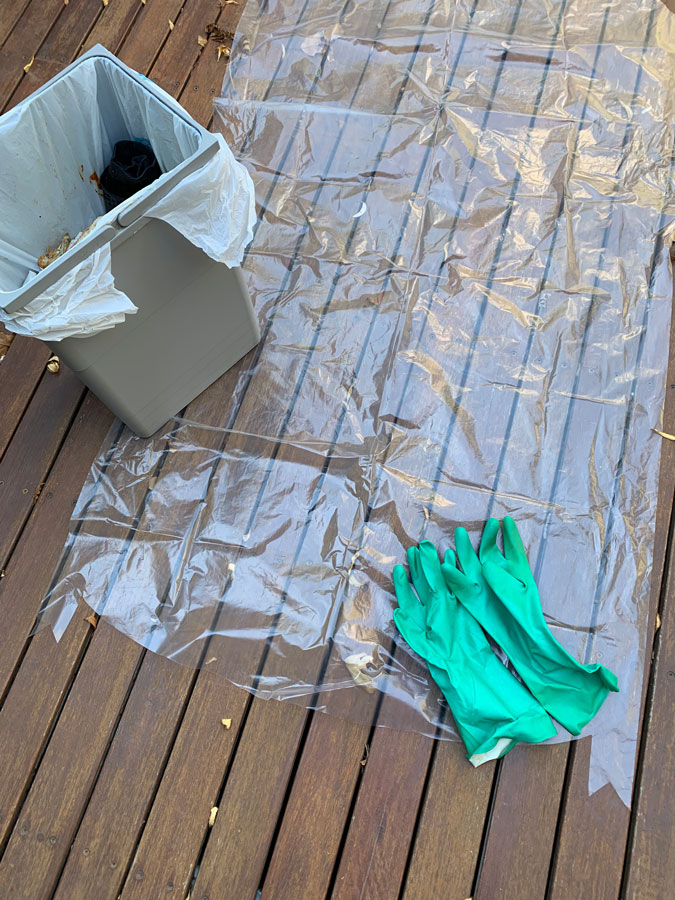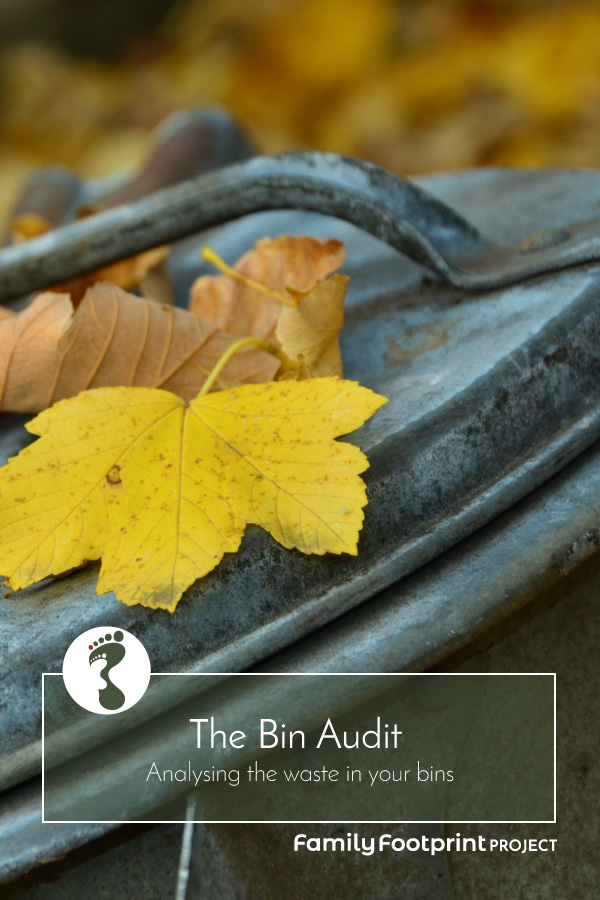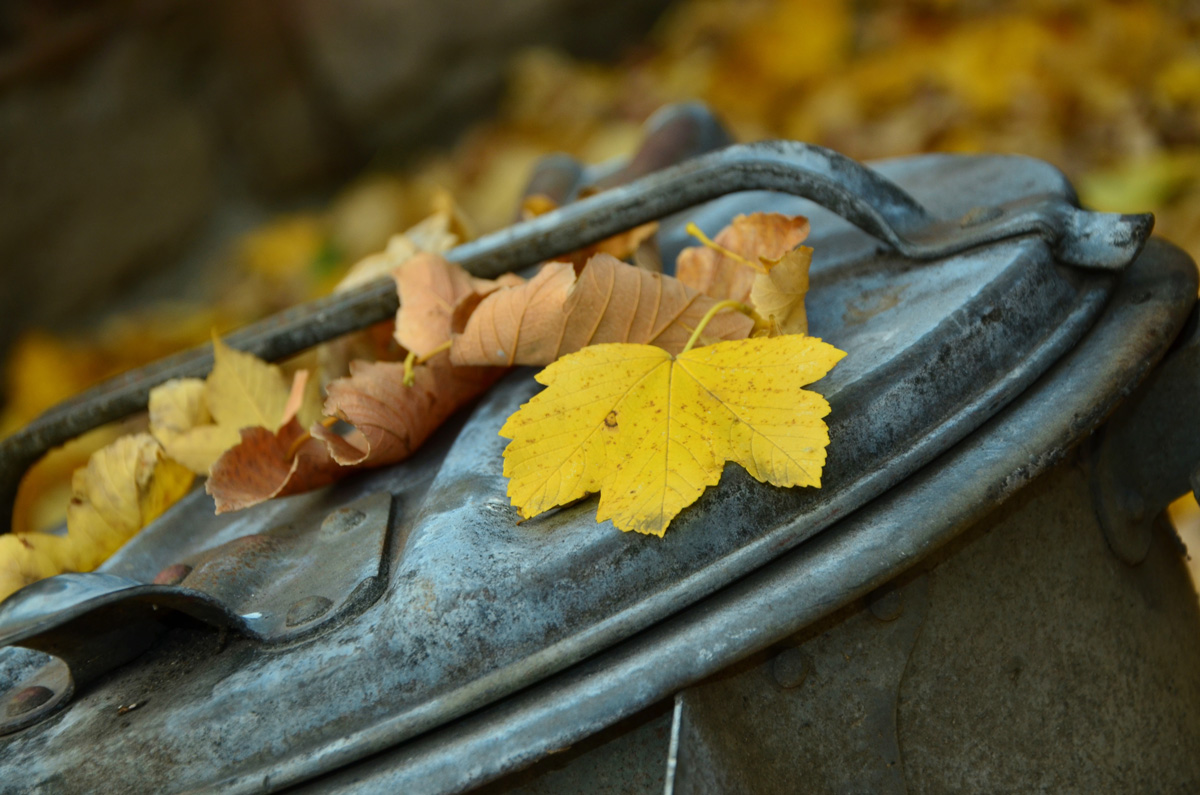If you watched the ABC’s War on Waste you will have seen a few bin audits. Unpleasant though they may be, they are an invaluable way to see what really goes into your bin and take stock of where to start with this aspect of your Family Footprint Project.
I did my own bin audit to begin our project. I’ll tell you more about what I found later. First, how do you do your own bin audit?
How to do a bin audit
I’ve heard of two ways to do this. The first is the method used on the War on Waste which is to lay the contents of your bin out and sort it. The other way is to keep a tally as you throw stuff into the bin. This second way might be less ‘ick’ but relying on myself, let alone the other members of my household, to remember to do this every time is setting ourselves up to fail! Really, I think for families, the first method is the only way to go. Sorry!
It isn’t so bad though. Stick with me here…
Which bin?
You could do this process just with your “waste to landfill” bin but if your family are already avid recyclers, I would suggest also doing this for your recycling bin. Recycling, though streaks ahead of sending stuff to the tip, is in itself problematic. I’ll discuss this more in another post. Ideally, we need to consider all aspects of our waste stream and look at ways to reduce even those things that might have a second life.
So take these steps for each of your waste types. For me it was ‘waste to landfill’, mixed recyclables and soft plastics. I didn’t consider organics going to the worm farm but I will discuss food waste in another post.
Tip it all out & sort it

On the day you put out the bins for collection, lay out a small tarp or drop sheet and don your rubber gloves. I recommend doing this in a well ventilated area. I did it on my back deck but I had to lock up the dog!
Tip the contents of the bin onto the tarp and separate the contents into categories. The categories depend on the type of waste you are dealing, your local waste management guidelines, your household and how closely you want to scrutinise your waste production. These are some examples:
“Waste-to-landfill” bin
- Household recycling items (e.g. paper, glass)
- Other recyclable items (e.g. batteries)
- Textiles
- Food waste
- Broken household items
- Waste for landfill (e.g. nappies)
Mixed recycling bin
- Rigid plastics
- Paper & cardboard
- Glass
- Aluminium & Steel
Soft plastics recycling bin
- Grocery packaging
- Snack packaging
- Plastic wrap
Analyse it
When you have your piles, look at what is in each and make a note of the kinds of things you find. You are looking for:
- things that you could divert from that waste stream, such as recyclables in the ‘waste-to-landfill’ bin;
- excesses in a particular area which might indicate priorities areas for change; and
- items which might indicate habits and practices that could be changed, such as disposal of repairable items.

Estimate it
Now, a dedicated statistician would now weigh the contents of each category at this point and enter all the data into a spreadsheet. Go right ahead if that is your thing. I just took photos at this point to refer to later.
Clean it up
So you can let the dog (or children!) out of the house again, you’ll need to clean it all away of course. You might like to divert items into more suitable streams at this point, that is, you might want to put the recycling into the recycling bin and the food waste in the worm farm for example.
What I found in my bins
I won’t bore or sicken you with the contents of my bins. I felt like I chose a particularly yukky week to rake though our detritus. It was pretty gross! I do, though, want to list a few interesting findings from my own bin audit.
Waste to Landfill Bin
Food waste not suitable for worms
We have a worm farm and a lot of our food waste goes in there but there are some things such as chicken carcases that are better not given to the worms or put in open compost. I want to look into something like Bokashi bin for things like meat and dairy.
I have another post talking more about minimising food waste.
Paper towel
Although we use Who Gives a Crap ‘treeless’ paper towels, I found an awful lot of them in the bin. I have personally reduced my use of paper towel dramatically. I use tea towels for all manner of things now! The kids, however, need some strenuous education about paper towel use. And what we do use can be composted.
Soft plastics
I found lots of soft plastics which could have been put into our soft plastic recycling. Another area for family education…
Pet waste
Ah, the little plastic baggies of doggy poop. We are, of course, responsible pet owners and pick up Lucy’s ‘do’. I intend to make a dog poo compost system (it shouldn’t go into the regular compost) but I’m still struggling with a plastic bag free way to collect her waste when we are out for a walk.
Black plastic food trays
Rigid plastic meat trays can be recycled but the black ones are not detected by the sorting machine at the recycling plant.
Recycling Bin
Milk cartons
We go through an extraordinary amount of milk in our household. If you have teenage sons, you might find the same thing. I just don’t know what to do about the not inconsiderable amount of plastic waste we are producing in this area. I feel like glass bottled organic milk in these quantities would actually bankrupt us.
Difficult to recycle items
Some things, such as cosmetic products, are packaged in materials that, although could be reused such as rigid plastic and metals, are fused with together so they cannot be recycled in the household recycling stream. Terracycle does deal with these types of waste but drop off locations are not easy to find and, in my area, are limited to oral care and contact lenses. I’d like to look more closely at this and see if there is anything I can personally do to improve the sitation.
Soft Plastics Recylcing Bin
Grocery packaging
There is lots to improve here and lots of easy ways to do it. Buying some of our dry groceries from the bulk goods stores nearby is one. Making my own pasta is another.
Bread bags
I’ve pretty much eliminated bread bags from our waste by using a reusable bread collection bag and buying non-sliced bread in paper bags.
Snack packages
Clearly our diet includes way too much junk food! Chip and lolly packaging was way over represented in this bin. Teenagers buy their own junk and, to this point, my ‘encouragement’ to eat more healthily has not had a visible impact!
Plastic wrap
We actually don’t use much plastic wrap anymore having found ways to replace it. We use beeswax wraps, sealed containers and the good old tea towel where we used to use plastic wrap. I did find plastic wrap in this bin though, that had been wrapped around fresh produce and that sort of thing.
Where to from here?
So we have some clear things we can make a start on as a result of my bin audit. I’ll report on our progress and the steps we take in coming weeks.
If you do your own bin audit, I’d love to hear what you discover and the changes you plan to make. Leave a comment below.
[mc4wp_form id=”96″]


